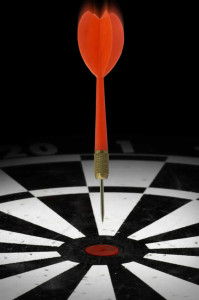
Setting SMART goals with LOA will boost your success rate tremendously!
If you’re a regular reader of my blog, then you’ve seen the last few posts on goal setting versus resolutions, how to use a vision board to help you stay focused and enthusiastic about your goals and how to achieve your goals with the Law of Attraction. But there’s one more goal-setting resource I’d like to share with you that will give you some hard-core, useable strategies to skyrocket your success rate in achieving your goals!
Setting SMART Goals
I came across a really awesome resource for goal setting this year that I’ve added my own little LOA twist to and have since been using extensively to help me with my own goals. It’s called SMART goal setting, and here’s how it works: SMART is a mnemonic for Specific, Measurable, Aligned, Realistic, and Time-bound goals. The theory is that if you make sure your goals are specific rather than general, measurable rather than subjective, aligned with your values, realistic, and bound by a real deadline, you are much more likely to follow through and make them happen.
Let’s break it down:
Specific

SMART goals are specific, rather than general.
This first step helps you to define your SMART goals clearly. It is super-important because a specific goal, with no vagueness or room for interpretation, is much more likely to be achieved than a general one.
For example, if you have a goal to “get fit”, it just isn’t specific enough. It’s too wishy-washy, and doesn’t really give you a bold statement of what you’re trying to do (what counts as “fit’?) If your fitness goal is to “become more flexible”, it still isn’t specific enough because it’s too open to interpretation (what counts as “more flexible”?) For a goal to be useful to you it must be as specific as possible; for instance, your flexibility goal might be: “To be able to touch my toes again.” This is a very clear and easily understandable goal, so you know exactly what it is you are going to accomplish.
Measurable

SMART goals can be objectively measured.
There is a maxim among corporate project management types that “if you can’t measure it, you can’t manage it”, and this is also true for personal goal-setting.
To help you with this step, there are two questions that you need to ask yourself about your goal:
- How will I know when I’ve achieved my goal?
- How will I know that I’m making progress towards my goal?
If you’re goal is to be “be famous”, for instance, how will you know you’re famous? Are you famous when people you don’t know ask for your autograph? Or when you’re on the front cover of a grocery store tabloid? Or when you’ve won an Oscar for best actor? What has to happen for you to know you’ve officially reached your goal and are now “famous”?
Likewise, until you’ve reached that official goal point, how will you know you’re on the right track? How will you know that you’re on your way? If you have milestones that you can track as you work towards your goal, it will give you the proof that what you’re doing is “working” and the excitement of meeting each of these “mini-goals” will give you the emotional boost and determination required to achieve your larger goal.
Aligned

SMART goals are aligned with your values.
This is where I’ve added my Law of Attraction bit. 🙂 In the official version of this system, the “A” is actually for “achievable”, but I find “aligned” resonates a lot more for me: Are your goals aligned with your beliefs and values? Are your goals really the ones you want or are they goals you’ve set because you, or other people, think you “should” or “ought to”?
If your goals are not in alignment with Who You Really Are, you will not attain them, plain and simple. There will be something inside you that rebels against them, and does everything in its power to make sure they don’t happen. And if by some miracle, you do manage to drag yourself, metaphorically kicking and screaming all the way through to the finish line, you’re still not going to be happy, so why bother? SMART goals have to remain true to your own core values and belief systems.
For example, if your goal is to go the gym three times a week because you think you “should”, you might start out with the steely determination to make yourself do it, but you won’t enjoy it, and sooner or later you’re going to find every possible excuse for not going (you have to get that document finished for work tomorrow so you don’t have time, it’s raining and the road might be slippery so best not to go, you’ve got a bit of a sniffle and might be coming down with something so better to stay home and rest, etc.). In this case, perhaps a re-evaluation of your goals might be in order: if you really want to get more exercise, but hate going to the gym, why not make it your goal to leave your desk and go for a walk every lunch hour, instead?
Realistic

SMART goals are achievable.
For a goal to be effective, it must be “do-able”; it must be one you believe you can actually achieve. You want to set a goal that will stretch you, that will require you to make a real commitment, but at the same time, you don’t want to make your goal so far out of reach that you don’t really believe it can be done.
If the goal is too difficult, you won’t commit to doing it, and even if you try, your subconscious mind will sabotage you with every limiting belief it can throw at you, effectively burying the goal before you even get going. But if the goal is too easy, you’re sending yourself the subconscious message that you aren’t capable enough to handle a “real” goal, and attaining it will not bring you any real satisfaction. Set your SMART goals so that they require some real effort on your part; set the bar high enough that it will really mean something when you accomplish your goal, but don’t set it so high that you doom yourself to failure before you’re even out of the gate.
For example: If your goal is to be Prime Minister (or President) within two years, but you have never had any experience in politics or speaking in front of large audiences, you know it’s not an achievable goal. You can still plan on being President, but in the meantime, you might make it a goal to volunteer in your local MP or governor’s office to learn the ins-an-outs of a political environment. You might also decide to join Toastmasters and make it your goal to earn your Competent Communicator status within a year. These are both realistic, attainable goals that could also help you achieve your larger goal.
Time-bound

SMART goals are time-bound.
Finally, for a goal to be SMART, it must be time-bound. This means you have to have a concrete time frame and target date for achieving your goal. If you commit to a deadline, you’re much more likely to achieve it, and not let your other day-to-day tasks overshadow your goal or dream.
More importantly, without a clear finish-line, you will not have any sense of urgency or pressure to start taking action now. Without a clear timeline, there’s no real commitment because you’re going to feel that you’ll get started on that goal “sometie” or “whenever”. And then you just never quite get around to getting started so you never do achieve your goal. So give yourself a deadline: When will you have achieved this goal? Next week? In two months? Before your next birthday? SMART goals are time-bound with defined deadlines or target dates.
SMART Goals and the Law of Attraction
So there you have it: If you make your goals specific, measurable, aligned with your core values, realistic, and time-bound, you are far more likely to follow through and actually achieve them. And when you use SMART goals in conjunction with Law of Attraction based techniques like vision boards, your ability to achieve those goals becomes super-charged and extraordinarily powerful. You are in essence mixing mind power with muscle power (i.e. the power of the Universe and your beliefs with the power of your physical actions) for an unstoppable dynamic combination! And with that kind of unlimited power fueling you, how could you possibly NOT achieve your goal? 🙂
And for my final word on this, I just want to share a really cute example of great goal-setting in action: my 6 year old nephew wanted to be a “good reader”, so he set himself the goal of reading 100 books by himself. His mother made him a chart on a big piece of Bristol board with 100 squares in it and the goal written at the top: “I read 100 books!” (I don’t think she actually knows anything about the Law of Attraction, but holy heck… she intuitively knew to put the goal in past tense, automatically presuming in everyone’s mind that goal was/would be completed! How LOA is that? :-)). Now, every time he finishes reading a book, he puts a sticker in one of the squares, so he has a very visual way of tracking his progress, which spurs him on as he can see himself getting closer and closer to achieving his ultimate goal. Awesome!

















Hi Nathalie! I love this post! Thank you!
Your words work for me in a kind of opposite-to-intended way. I realize that I’ve set a goal which is out of my control, that of having great sales for my novels on Amazon. I need to remember all the time that my own goal is to make them available in an attractive way. Period. What happens after that is in the capable hands of the Universe. The more I push, the more frustrated I get, which is the opposite of letting go of the outcome!
I am given amazing evidence every day that the Law of Attraction REALLY works. Just yesterday, a yearned for outcome came about in a totally unexpected and dramatic way. The impulse to republish my novels is the Universe giving me the opportunity to learn to release the outcome in a concrete, compelling situation (without anyone being sick or dying, thank you Universe). I must be ready, or the opportunity wouldn’t have come.
And thank you Nathalie, for putting the words in front of me that remind me yet again…
Huge hugs,
Carole
Hi Carole — I see three ways of looking at this:
1) Do you have a specific, measurable goal for your book sales? “Great sales” is too vague for concrete goal. Do you want to make 5 sales per month? 10 sales? 100 sales? What would constitute “great sales” for you?
2) I didn’t get into it in this post (though it will be in my upcoming book), but the concept of inspired action definitely is one to be aware of when working towards a goal. If the marketing aspects of selling your book feel like pushing to you, then it’s definitely better to back off for now. Frustration definitely doesn’t help with manifesting any kind of goal!
3) If you’ve taken a closer look at your own values and found that what you want most right now is to make beautiful books available to people, then that is definitely the area to concentrate on. You’ll have much greater success with that. It doesn’t mean that you won’t work on marketing and sales in the future — you might, if you find yourself drawn in that direction later. Goals and desires evolve and change along with our experiences.
Also, what you said about “I must be ready, or the opportunity wouldn’t have come” was brilliant! (And fits in beautifully with that whole inspired action thing.) I know exactly what you mean. I started thinking about launching this very blog months ago, and I had all sorts of ideas for it and things that I wanted to do, but I just could never get myself to actually start it. And one day I was just messing around testing out various possibilities for a blog name — checking to see whether any of the names that I was thinking of were still available as site names, and when I saw that “Vibe shifting” was available, it was as if everything just clicked. I’m still kind of amazed at how much I’ve managed to accomplished in such a short time. Reading your comment… I must have been ready or the opportunity wouldn’t have come! 🙂
Hi Nathalie!
“Vibe shifting” is certainly an appropriate name for your site! And a lovely site it is!
Which is the topic of my comment. I used to make goals for myself. However, there was a whole slew of things I also wanted, that the universe granted, for which I am deeply appreciative. These goals could not be written on paper, for they had to happen on their own, by me living my life. It was personal stuff, like having a thrilling, fantastic social life, which I would not have attained had I written it on paper or possibly followed my list of goals as I had planned.
What I am trying to say is, the universe knows and grants as necessary. It really does know when to give something. It knows the timing of a situation. It also gives us stuff we want to try out, knowing full well they are not for us, but the only way we can see that is to actually experience them and figure it out on our own. That is the only way we learn, as humans, even if our soul knows everything, but is along for the ride, so we experience that stuff anyway.
Even if the universe grants us something we are not ready for while we have our eye on something else, we can always go back to it since, 1. the universe granted it, and 2. what we had our eye on did not work out, but we satisfied our curiosity. Working with the universe is a great thing! Life leads us to where we need to be, regardless of time. If one is not ready for something this red hot minute, they can be perhaps two years from now. This is under the alignment portion you so well added, because that is the crux of the whole thing. If you can’t learn to drive because you have anxiety, it would be best to approach it when you do not have it in the near future.
Also, not giving up when everything is crumbling around you is vital. so many gave up after the first failure and went in another direction, fooling themselves because, had they stuck with it a while longer, it would have happened. But they mistook the failure as “not meant to be”. I recently read the spiritual laws of success and it blatantly stated that if you are not willing to try something till the death, for which the universe will justify you and in the next life you will succeed easily no matter what, then you are not serious about your goal. If you have the feeling of “I will die if I do not do it”, then you are on the right path. If not, then not really, but most of society lives and settles this way. There is great passion in the universe and you can say that it is passion-oriented, or feeling oriented. It may sound dramatic, and it certainly is. I guess humans watered everything down to make them feel more secure, but that is just the opposite of how you need to be.
It is not possible to let go of a dream, since it comes from the ether and it gnaws and tortures your heart until you take steps, as baby as they may be, toward the dream to eventually fulfill it and viola! A fulfilled life! Only a small percentage of humanity actually experiences this!
And as for regrets, I know we should not have them, but perhaps, if something we did not do still pulls at our heart, then it is time to look into it further and do it, so it can be done! Even the word impossible has I’m possible in it, so everything is possible, at least in the universe’s eyes, which are the only ones that really matter.
Please forgive the long comment. I had to let that out today! I feel great and thank you so much for your blog!!!
Hello A! This is a big long comment with lots of really important points, so I’m going to give you a big long response to answer each of those points… hang on to your hat!
First off, are you sure that writing your goals down would have made them unattainable? Or is that a limiting belief? 😉
Personal goals, like having a better social life, actually can be set just like any other kind of goal — material or otherwise. It’s a just a matter of what kind of actions you take afterwards. Personal goals often involve more mental prep work than tangible or material goals, but you can take action towards them just the same.
The Universe definitely does know everything, but I’m not sure that it “grants as necessary”. My understanding of this is that the Universe can, will and does grant us everything that we ask for. Everything. The key is that it grants everything that we ask for, even when it’s an unconscious desire rather than concscious one. And if there is a conflict between the conscious and unconscious desires, the stronger ones will be the ones we end up manifesting.
So all the crap that we sometimes find ourselves manifesting, we have manifested because on some, generally unconscious, level we “asked” for it, and our unconscious asking for the stuff we didn’t want was stronger than our conscious asking for the stuff we did want. Remember that fighting against something or focusing on “not wanting” something is the same thing as asking for it; the Universe is inclusive — it doesn’t hear “not”
This is where the alignment bit comes in, and you’re right — if you’re not ready for it right now, because you’re not in alignment with it, it’s not going to happen. Everything that happens, happens because you are in alignment with it, whether you want it or not. So if, as per your example, you want to learn to drive but have anxiety about it you can still make it your goal, even if you are anxious about it, but you would definitely want to work on the anxiety issues first; this mental work is where things like affirmations and mantras can be really helpful! Generally speaking, when you’re really ready for something you want it’s easy to get into alignment with it.
I don’t believe that there are any real failures in life, just steps along your path… stepping stones and opportunities for knowledge and growth. If you look for the positive in any “failure” you will find it, and if you learn from it and move on, it can never be a true failure.
You’re right about it not being possible to truly let go of a dream. Even if you don’t follow it, it will pull at you. But it is never too late to move forward! Everything truly is possible. 🙂 And keep in mind that dreams can and do change, and that that’s OK, too. The dreams you have in your 20s will most likely have evolved, and may even be completely different by the time you’re in your 40s.
From my understanding, there is no justification or judgement from the Universe, the Universe loves you unconditionally exactly as you are. It doesn’t matter whether you tried “to the death” to achieve something or not… the fact that you are is reason enough for the Universe to adore you. There is no judgement, there is no “do this or suffer in the next life” or “do this and have an easier next life”. You are here because you chose to be here. And should you choose to come back for another round it will be just that — your choice.
The right path for you is the one that feels right to you, and that path may very well change direction as you yourself grow and change through your life experiences… and that is as it should be. If you expect the Universe to be judgemental and “do or die”, it will be… for you, because it loves you so much that it will give you even that. But it doesn’t have to be hard, and it doesn’t have to be scary like that.
As a side note to the last point: Have you signed up for Mike Dooley’s Notes from the Universe? You might like them… I think they’ll give you a whole different, and more positive way, to look at and interpret things. Plus they’re just so gosh darned inspirational… 😉
Nathalie,
That was great! Thanks for this. It made me realize that something is holding me back from something and I have to let that go and ease up a bit. There is nothing to fear, either, because, hey, the universe is on our side anyway, so why the heck do we fret so? it is mostly conditioned behavior, at least for me, but I am slowly learning to release all of that stuff and feel more in the flow of things, you know…